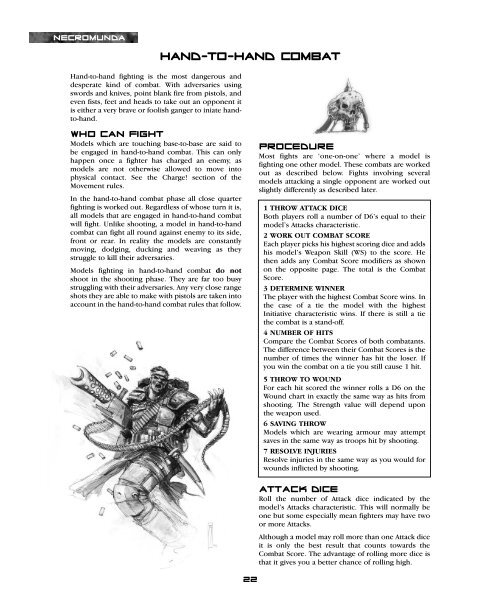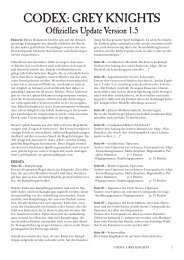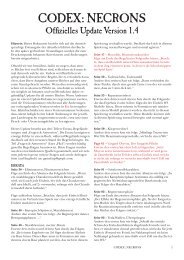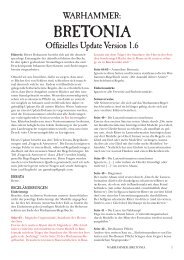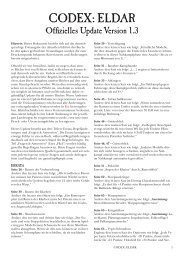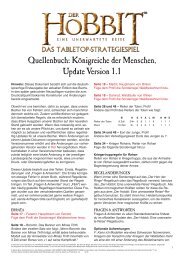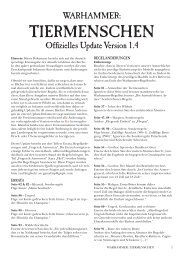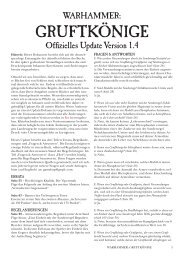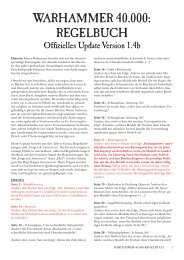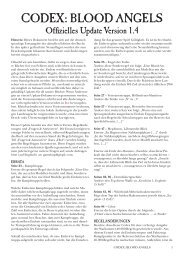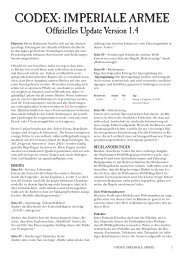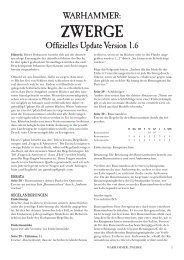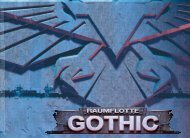Necromunda rulebook - Games Workshop
Necromunda rulebook - Games Workshop
Necromunda rulebook - Games Workshop
Create successful ePaper yourself
Turn your PDF publications into a flip-book with our unique Google optimized e-Paper software.
NECROMUNDA<br />
Hand-to-hand fighting is the most dangerous and<br />
desperate kind of combat. With adversaries using<br />
swords and knives, point blank fire from pistols, and<br />
even fists, feet and heads to take out an opponent it<br />
is either a very brave or foolish ganger to iniate handto-hand.<br />
WHO CAN FIGHT<br />
Models which are touching base-to-base are said to<br />
be engaged in hand-to-hand combat. This can only<br />
happen once a fighter has charged an enemy, as<br />
models are not otherwise allowed to move into<br />
physical contact. See the Charge! section of the<br />
Movement rules.<br />
In the hand-to-hand combat phase all close quarter<br />
fighting is worked out. Regardless of whose turn it is,<br />
all models that are engaged in hand-to-hand combat<br />
will fight. Unlike shooting, a model in hand-to-hand<br />
combat can fight all round against enemy to its side,<br />
front or rear. In reality the models are constantly<br />
moving, dodging, ducking and weaving as they<br />
struggle to kill their adversaries.<br />
Models fighting in hand-to-hand combat do not<br />
shoot in the shooting phase. They are far too busy<br />
struggling with their adversaries. Any very close range<br />
shots they are able to make with pistols are taken into<br />
account in the hand-to-hand combat rules that follow.<br />
Hand-to-hand Combat<br />
22<br />
PROCEDURE<br />
Most fights are ‘one-on-one’ where a model is<br />
fighting one other model. These combats are worked<br />
out as described below. Fights involving several<br />
models attacking a single opponent are worked out<br />
slightly differently as described later.<br />
1 THROW ATTACK DICE<br />
Both players roll a number of D6’s equal to their<br />
model’s Attacks characteristic.<br />
2 WORK OUT COMBAT SCORE<br />
Each player picks his highest scoring dice and adds<br />
his model’s Weapon Skill (WS) to the score. He<br />
then adds any Combat Score modifiers as shown<br />
on the opposite page. The total is the Combat<br />
Score.<br />
3 DETERMINE WINNER<br />
The player with the highest Combat Score wins. In<br />
the case of a tie the model with the highest<br />
Initiative characteristic wins. If there is still a tie<br />
the combat is a stand-off.<br />
4 NUMBER OF HITS<br />
Compare the Combat Scores of both combatants.<br />
The difference between their Combat Scores is the<br />
number of times the winner has hit the loser. If<br />
you win the combat on a tie you still cause 1 hit.<br />
5 THROW TO WOUND<br />
For each hit scored the winner rolls a D6 on the<br />
Wound chart in exactly the same way as hits from<br />
shooting. The Strength value will depend upon<br />
the weapon used.<br />
6 SAVING THROW<br />
Models which are wearing armour may attempt<br />
saves in the same way as troops hit by shooting.<br />
7 RESOLVE INJURIES<br />
Resolve injuries in the same way as you would for<br />
wounds inflicted by shooting.<br />
ATTACK DICE<br />
Roll the number of Attack dice indicated by the<br />
model’s Attacks characteristic. This will normally be<br />
one but some especially mean fighters may have two<br />
or more Attacks.<br />
Although a model may roll more than one Attack dice<br />
it is only the best result that counts towards the<br />
Combat Score. The advantage of rolling more dice is<br />
that it gives you a better chance of rolling high.


